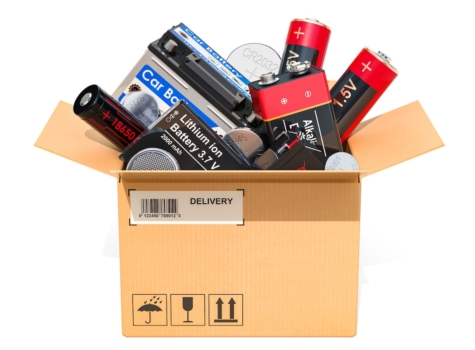Batteries power some of our most essential electronics: phones, laptops, medical devices, and more. Can you imagine a world without them?
But batteries have a sinister side. When they’re not handled properly, they can catch on fire or even explode. Needless to say, exploding packages are a no-go for carriers, so it’s important to double-check your packages when shipping batteries or related products.
By following all applicable rules and regulations regarding the transportation of batteries, you can mail them with confidence. Let’s dive in!
What products have lithium batteries?
Many products and equipment that we use in everyday life—such as portable electronics, wearable technology, small appliances, and more—are powered by lithium batteries. A few common examples include:
- Mobile phones
- Tablets
- Laptops
- Digital cameras
- Watches
- Fitness trackers
- Bluetooth headphones
- Hearing aids
- Cordless drills
- Electric shavers
There are also times when unexpected items contain batteries. Some of the more “hidden” uses of batteries include:
- Greeting cards. Some musical or interactive greeting cards have small button cell batteries.
- Books and toys. Children’s books with sound effects and many modern toys have embedded batteries.
- Shoes. Some sneakers, especially those designed for kids, have battery-powered lights that activate when you step.
- Jewelry. Earrings, necklaces, and other jewelry can sometimes light up, vibrate, or have other features powered by tiny batteries.
- Household items. Things like digital thermometers, some kitchen scales, and even salt and pepper grinders might have batteries.
- Keychains. Keychains sometimes include light or sound features that require batteries.
- Furniture. Some reclining chairs and couches have battery-operated features for adjusting positions
- Glasses. Some illuminated reading glasses or party glasses might contain tiny batteries.
Why are batteries considered “dangerous goods”?
Lithium batteries are considered dangerous goods because they contain lots of electrical energy, causing them to generate heat, catch on fire, and even explode if they short circuit or get damaged. The chemicals batteries contain make it difficult to extinguish fires, which can spell disaster for planes or cargo ships. For this reason, the transportation of lithium batteries requires strict regulations to prevent accidents, and batteries can’t be shipped by plane. The best way to ship batteries is to use standard shipping, which is typically done by ground transportation.
Can you mail batteries?
Even though batteries are considered dangerous goods, you can legally mail them. As long as they’re not damaged or defective, and packaged and labeled correctly, you can safely mail batteries either alone or within products.
The difference between lithium-metal and lithium-ion batteries
Lithium-ion (Li-ion) batteries, sometimes called secondary lithium batteries, are rechargeable and contain lithium compounds rather than pure lithium. Although lithium-ion batteries aren’t as volatile as lithium-metal batteries, they can still pose major safety risks when damaged, defective, or exposed to extreme conditions.
Lithium-metal batteries are long-lasting batteries that use metallic lithium as one of their primary components. They have a higher energy density than lithium-ion batteries, and they aren’t usually rechargeable. Because lithium batteries are more dangerous than lithium-ion ones, they’re subject to stricter shipping regulations, and some carriers won’t ship them.
How to ship lithium batteries
While shipping batteries is possible, you should maintain high safety standards to prevent accidents. We recommend following the carrier’s instructions, using the right packaging materials and techniques, and labeling packages correctly.
1. Use the right packaging materials and techniques
Using the right packaging materials isn’t just about keeping batteries from getting damaged—it’s about preserving the safety of your entire shipment and the carrier that’s handling it.
Use strong outer packaging
The first step in packing batteries is to choose a rigid outer material that can’t easily be crushed, such as a sturdy corrugated cardboard box. Never use envelopes, bubble mailers, or other soft packaging.
Keep in mind that dangerous goods generally need to be packed in UN specification packaging, which has passed tests to prove that it can withstand drops and pressure changes. Many vendors sell packaging that has met the UN requirements.
Cushion the batteries using filler material
Keep the batteries secure with non-conductive filler material such as bubble wrap. They shouldn’t be able to shift around during transport.
Individually wrap batteries with insulated material
When the positive and negative nodes of batteries connect, the resulting short circuit causes high amounts of energy to flow, releasing heat that can cause fires. Short circuits can push batteries into thermal runaway, a self-sustaining chain reaction that increases the likelihood of fire or explosion.
You can prevent short circuits and thermal runaway by covering battery terminals in insulated material. If the batteries are in their original packaging, leave them that way. If not, cover their nodes using tape or plastic caps, or pack each battery in its own plastic bag.
Avoid contact with metals
Because metal can cause batteries to short circuit, you should make sure there is no direct contact with metal objects when shipping batteries.
2. Label the package correctly
While you should follow the specific labeling instructions provided by your carrier (see below), here’s some of the information you might be required to include:
- Proper shipping name. This is a description of the lithium battery’s contents, such as “Lithium-Metal Batteries” or “Lithium-Ion Batteries.”
- Watt-hour rating or lithium content. The watt-hour rating or lithium content of the batteries may need to be specified on the package.
- UN ID number. Include the UN class number, which is UN 3090 for standalone lithium-metal batteries, UN 3091 for lithium-metal batteries packed in equipment, UN 3480 for standalone lithium-ion batteries, and UN 3481 for lithium-ion batteries packed in equipment.
- Class 9 Lithium Battery hazard label. Lithium batteries of a certain size need a Class 9 hazardous materials label.
- Lithium Battery Mark. Batteries may also require a lithium battery mark that includes the UN ID number and a phone number to call for additional information about the shipment.
- Cargo Aircraft Only (COA) label. This label shows that the package can only be transported on cargo planes, not passenger planes. You should add it if the batteries are being shipped by air.
- Special handling instructions. Include any special handling instructions, such as “Do not load with flammable materials” or “Handle with care.”
- Shipper and recipient information. The name and address of both the sender and receiver should be clearly indicated on the package.
For more details on labeling battery shipments, view the Department of Transportation’s guide or read the IATA regulations on shipping batteries by air.
3. Fill out the required documentation
While carrier requirements differ, you’ll probably be required to complete and submit the following types of documents before shipping batteries.
- Dangerous goods declaration (DGD). When shipping lithium batteries, a DGD or equivalent form is usually required. This form provides specific details about the hazardous materials being shipped, including their UN number, proper shipping name, class, packing group, and any special handling instructions.
- Material safety data sheet (MSDS). These documents contain important safety information about the batteries, including their chemical composition, hazards, and recommended safety measures.
- Hazardous Materials (HM) shipping paper. The Department of Transportation (DOT) requires businesses to provide an HM shipping paper, which provides essential information about the transportation of hazardous materials.
- UN 38.3 certificate. This document proves that lithium batteries have successfully undergone a series of tests designed to determine their safety during transport.
- Packing certificate. Some regulations require shippers to provide a packing certificate that confirms compliance with packaging requirements, such as UN-certified packaging for hazardous materials.
- Emergency response information. Provide information on how to respond to emergencies involving lithium batteries, including contact details for emergency responders.
Note that employees involved in preparing batteries for shipment need to go through the DOT Hazmat Training.
4. Follow the carrier’s instructions
Following the instructions above will help you package, label, and document lithium battery shipments the right way. But carriers also have their own rules regarding the mode of transport you can use, what types of batteries cannot be shipped, and how you should label packages. See our USPS guide to see the process.
View the carrier guidelines below to learn more.
- USPS battery shipping guidelines
- UPS battery shipping guidelines
- FedEx battery shipping guidelines
- DHL battery shipping guidelines
How to ship products with lithium batteries inside
Many businesses don’t just ship boxes of batteries—they send out products that run on batteries, such as small appliances, mobile phones, smart devices, toys, and more. So what precautions should you take when sending products that contain batteries? While you should refer to the guidelines above, keep these tips in mind too.
1. Use the right packaging
Even when batteries are already installed in devices, you need sturdy packaging. Choose strong outer materials and inner cushioning material that will keep the package’s contents from being crushed or jostled during transit.
2. Keep devices turned off and cover switches
Any devices with batteries installed should be turned off while they’re shipped. Cover any switches that could accidentally be bumped during shipping so the product stays off.
3. Label the shipment correctly and complete the required documentation
Lithium batteries can pose a safety hazard even when they’re inside products. Because of this, you’ll need to label the package and complete extra documentation before sending packages. Refer to the instructions above, and make sure to double-check the carrier’s requirements.
Ship batteries safely with EasyPost
With so many rules surrounding shipping batteries, it’s important to proceed with caution. If you’re worried about staying compliant with the labeling and documentation, EasyPost can take some of the weight off your shoulders. Our suite of shipping APIs automates the shipping process by quickly comparing rates, identifying the best shipping options, and providing carrier-compliant labels. Ready to streamline your business shipping?




